I always say that you can find someone queer connected to virtually any major historical event. The American Revolution is no exception — and, in fact, without this person being queer, we would almost certainly have lost the war.
 Baron Friedrich Wilhelm von Steuben was born in Magdeburg in the kingdom Prussia on September 17, 1730. His father was the Royal Prussian Engineer Captain Baron Wilhelm von Steuben and his wife Elizabeth von Jagdovin. In his childhood, his father went into the service of Empress Anna of Russia, and young von Steuben traveled with his father to his various posts. They returned to Prussia in 1740, where von Steuben began to a formal military education, taught to him by Jesuits. This education — despite being from a Roman Catholic order — left him extremely critical of the Roman Catholic church. This was probably partly because his parents were devout Protestants.
Baron Friedrich Wilhelm von Steuben was born in Magdeburg in the kingdom Prussia on September 17, 1730. His father was the Royal Prussian Engineer Captain Baron Wilhelm von Steuben and his wife Elizabeth von Jagdovin. In his childhood, his father went into the service of Empress Anna of Russia, and young von Steuben traveled with his father to his various posts. They returned to Prussia in 1740, where von Steuben began to a formal military education, taught to him by Jesuits. This education — despite being from a Roman Catholic order — left him extremely critical of the Roman Catholic church. This was probably partly because his parents were devout Protestants.
Although it’s said he participated in one of his father’s campaigns when he was 14 (in the War of Austrian Succession) Von Steuben did not formally join the Prussian military until he was 17. He served as a second lieutenant in the Seven Years War, suffering an injury in the Battle of Prague in 1757. By 1759, he was promoted to first lieutenant — and then, in August, was injured again. After he recovered he was given the role of deputy quartermaster for the generals headquarters. In 1761, he became the adjutant of Major General Von Knobloch (who — according to my real quick research, is now most renowned for having had von Steuben as his adjutant. Not the most illustrious military career, it seems.) They were taken prisoner by the Russians, but eventually returned to the ranks of the Prussians and von Steuben was later promoted to captain and became the aide-de-camp (personal assistant, basically) to King Frederick the Great. In 1762, von Steuben was one of 13 officers chosen for instruction by the Frederick the Great himself.
However, despite his great success, at the end of the war in 1763, von Steuben was unceremoniously out of a job. Later in his life, letters would point to this being due to an “inconsiderate step and an implacable personal enemy.” While that’s definitely vague enough for lots of interpretation, given later problems in his life, it is easy to speculate exactly what might have been going on — he probably needed to take the discharge in order to keep someone quiet about his sexuality.
The next year, von Steuben joined the service of Petty Court of Hohenzollern-Hechingen — a little principality in Germany. He remained with the court until 1777 — earning himself the title of “Baron” along the way. He was the only member of the court to accompany his prince to France in 1771, hoping to borrow money. They returned to Germany in 1775 deeply in debt and with nothing to show for their efforts.
By 1777, von Steuben was pretty desperate for any sort of job where he could actually make some money. Fortunately, he’d impressed the Comte de Saint-Germain, Claude Louis, when they had met in 1763, and the count also believed that the Americans could really use someone with Prussian officer’s training. He summoned von Steuben back to Paris and introduced him to Benjamin Franklin. The Continental Congress was certainly eager for von Steuben’s experience and training, but they were already running into morale issues among the men when they would hire mercenaries from other countries and immediately make them officers. Franklin could not offer von Steuben an officer’s pay (or really any pay), and von Steuben was unwilling to work for less — he rejected the offer to fight in America and headed back to Prussia.
Where he was immediately accused of engaging in homosexual acts with soldiers while serving in the Hohenzollern-Hechingen court. Although the accusations were never proven, von Steuben realized they would cost him any chance at furthering his career in Europe — and might land him in jail or worse. He returned to Paris — while rumors about his sexual activities made their way to the colonies in America ahead of him — and spoke to Franklin again. I’m not saying Franklin was being open-minded for the time, so much as he was just desperate to get a really skilled Prussian officer on board in the war. He wrote a letter to George Washington exaggerating von Steuben’s credentials (calling him a “Lieutenant General in the King of Prussia’s service”) — there is some debate as to if this was an unintential mistranslation, or if Franklin was trying to counter the damage rumors might have done to von Steuben’s reputation.
Whether or not Washington had heard the rumors is unclear, but there is some evidence that Washington was more open-minded about homosexuality than most people of the time. More to the point, Washington knew the Continental army was hanging by a thread and had even written that without “some great and capital change…this Army must inevitably…starve, dissolve or disperse.” So Washington was very eager to work with von Steuben, and since the baron had agreed to work — at least initially — without pay, the Continental Congress was also quite eager. They forwarded travel funds, and so on September 26, 1777 von Steuben boarded the ship the Flamand and set off for the colonies. They arrived in Portsmouth, New Hampshire on December 1, 1777.
He and his companions — including Pierre Etienne Du Ponceau (who was probably his lover at the time) — traveled to Boston, and then to York, Pennsylvania where they met with the Continental Congress on February 5, 1778. There, arrangements were officially made — von Steuben would be paid for his service at the end of the war, if he survived and if the Americans won. He made the trek from York to Valley Forge, where conditions for the troops were pretty dismal after months of low supplies and an Inspector General who was a complete deadbeat. He was appalled at the conditions — though impressed at the American’s ability to withstand them — and immediately set to work whipping the Continental Army into shape. He did not speak English, but was fluent in both German and French which allowed him to communicate with some of the officers — Alexander Hamilton, Nathaniel Greene, and Captain Benjamin Walker helped translate for him. The former two also helped him write out his training program for the men.
Von Steuben was also appointed temporary inspector general of the camp. He examined the living conditions and their equipment, and set changes into motion regarding the layout of the camp and the sanitation of the camp. These changes included putting the latrines and kitchens on opposite sides of the camp, and having the latrines on the downhill side of camp. A hundred years later, the changes he made would be adopted as standard practice — but they had the immediate effect of improving the health and quality of life for the soldiers at Valley Forge.
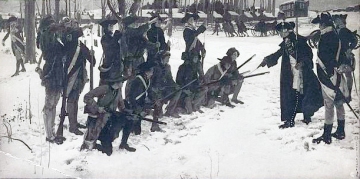 His training methods were also a hit — soldiers found him both impressive and entertaining, and found renewed confidence in themselves as they quickly mastered the tactics and maneuvers he instilled in them. He hand-selected 120 men (who became Washington’s honor guard) and trained them — mostly by barking at them, with Benjamin Walker translating. At a certain point, he began insisting that Walker translate not only his orders but also his (many) curse words. These 120 men, in turn, each trained other units of soldiers, who went on to train others, until the entire camp was trained. He had the entirety of the troops at Valley Forge trained by the end of April — just a few months after his arrival.
His training methods were also a hit — soldiers found him both impressive and entertaining, and found renewed confidence in themselves as they quickly mastered the tactics and maneuvers he instilled in them. He hand-selected 120 men (who became Washington’s honor guard) and trained them — mostly by barking at them, with Benjamin Walker translating. At a certain point, he began insisting that Walker translate not only his orders but also his (many) curse words. These 120 men, in turn, each trained other units of soldiers, who went on to train others, until the entire camp was trained. He had the entirety of the troops at Valley Forge trained by the end of April — just a few months after his arrival.
Von Steuben also implemented a new policy ensuring that troops received training before they were placed in a regiment — using this system of progressive training to make sure that could occur. Although commanding officers were in charge of making sure this happened, they would select their best sergeants to actually perform the training of new recruits. If any of this is sounding vaguely familiar, that’s because this is the groundwork for how our military still operates today.
Washington was greatly impressed, and suggested making von Steuben the permanent inspector general for the army with the rank and pay of a major general. Congress approved this recommendation on May 5, 1778. With this new position, von Steuben became aware of the lack of records being kept about supplies sent to the troops — he insisted that exact records be kept, putting an end to what he called “administrative incompetence, graft, war profiteering” and saving the Continental army an estimated five to eight thousand muskets.
While at Valley Forge, he was known for throwing wild parties in his quarters — to be admitted, it’s said, the only requirement to be allowed in was that no one was permitted to wear pants. I guess he figured that he’d been hired for the job in spite of fairly public allegations regarding his sexuality, so he could be more open about things than he’d been in Europe. He also began long-lasting romantic relationships with Benjamin Walker and Major General William North. This was all particularly brave since the first ever discharge of an American soldier (Ensign Frederick Gotthold Enslin) for committing homosexual acts occurred at Valley Forge at the behest of Lieutenant Colonel Aaron Burr in March of that same year — after von Steuben’s arrival.
Von Steuben’s training program was truly put to the test for the first time on May 20, 1778 with the Battle of Barren Hill. The British army attempted to entrap the Continental army — and although they technically won the battle, the Americans escaped with only three casualties. The next major proof of von Steuben’s training was the Battle of Monmouth on June 28, 1778. However, the greatest proof of the strength of von Steuben’s training was undoubtedly the Battle of Stony Point which took place on July 16, 1779 — the Continental Army launched a surprise attack on a British camp, with unloaded muskets. The Americans won the battle using only bayonets — and the tactics von Steuben had taught them for the use of bayonets.
Von Steuben compiled his training program into a book called Regulations for the Order and Discipline of the Troops of the United States — more commonly called the “Blue Book.” The Blue Book was the manual for the United States Army until 1814, and was stilled heavily referenced until 1846. And, as I said before, it laid out the groundwork for how we are still training the military (just with a lot fewer bayonets.)
In 1780, von Steuben was part of the court martial for Major John André — who was being tried for espionage in conjunction with the defection of Benedict Arnold. Afterwards, von Steuben traveled south to Virginia with Nathaniel Greene, and then took command of a 1,000 man militia whose job was, essentially, to ensure the troops would still be able to receive supplies and shipments while in the south. They fought in the Battle of Blandford in April of 1781, before joining with Nathaniel Greene as he campaigned in the south. Ultimately, this led them to bring 450 Continental troops to Lafayette. Von Steuben took ill at this point, and had to take a leave from his services to recover — finally rejoining the army just in time for the campaign at Yorktown (you know, the climactic siege that sealed Britain’s defeat. Gotta hand it to him, von Steuben had impeccable timing.) Washington split his troops into three divisions — giving von Steuben command of one of them.
So, anyways, as you may have heard, the Americans won the war. Von Steuben helped Washington demobilize the army in 1783, and helped to create a defense plan for the United States of America. In May of 1783, he oversaw the creation of the Society of Cincinnati. That same year, he was granted an estate in New Jersey — a place now called the Steuben House. The estate had suffered some damages in the war, and had been vacant for a few years, so von Steuben spent a great deal of money repairing it — despite not yet having been paid for his participation in the war.
He ultimately settled on Manhattan Island and lived, initially, with William North — who, along with Benjamin Walker, he had adopted. (That was — at the time — a fairly common way for gay people to get around the whole lack of same-sex marraige, and worked well in polyamorous situations like theirs too.) In 1785, von Steuben began to serve as the president of the German Society of the City of New York and the following year the New York legislature voted to make von Steuben a United States citizen. That same year, von Steuben wrote — under the alias “Belisarius” –encouraging Shay’s Rebellion by calling the government of Massachusetts an oligarchy. Shortly thereafter, North married a woman and moved into a home of his own. Whether not he continued his relationship with von Steuben while he was married is unclear but they did remain in contact.
No longer working in the military, Friedrich tried to be a businessman — without much success. In 1788, he determined that his estate in New Jersey had to be sold to pay off debts. Walker handled the sale of the property and saw to it that Friedrich’s debts were paid off. In 1790, Congress finally began paying out Friedrich’s pension — $2,500 a year (that’s roughly $69,604.08 in today’s value. Thanks Inflation Calculator!) With this helping to keep him afloat — and the assistance of Nathaniel Greene and Alexander Hamilton who helped him get a mortgage — he was able to move into an estate in New York state’s Mohawk Valley in Oneida County.
In 1791, he met a young John W. Mulligan, who had recently graduated from Columbia College and begun a relationship with Charles Adams (son of John Adams) and taken a job clerking for Hamilton. Charles and John lived together for two years, until John Adams made it clear that he would disown Charles if their “intense friendship” didn’t end. Friedrich offered that both could live with him — though only John accepted the offer. He took a position as Friedrich’s live-in secretary in 1793 and they began a romantic relationship. (John also seemed to have feelings for Benjamin Walker and William North — a happy little polyamorous relationship, as far as I can tell.)
Friedrich died on November 28, 1794 at his New York estate. William North and John Mulligan were with him. His real estate property and what money he had was inherited by North and Walker — Mulligan inherited Friedrich’s library and collection of maps, as well as $2,500. The estate is now part of the town of Steuben, New York — which was just one of several places named after him. A handful of military vessels have also born the Von Steuben name in his honor — including a German submarine (the SS Kronprinz Wilhelm) captured during World War I was renamed the USS Von Steuben, and in World War II the Germans named a passenger ship that they turned into a gunship the SS General Von Steuben.
 Von Steuben Day is a holiday that occurs in mid-September every year and which celebrates German-American culture and contributions to the country — the New York Von Steuben Day Parade is one of the largest parades in New York City every year. Chicago also holds an impressive Von Steuben Day parade, which was featured in the movie Ferris Bueller’s Day Off. There is a also statue of him in Lafayette Square in Washington, D.C.
Von Steuben Day is a holiday that occurs in mid-September every year and which celebrates German-American culture and contributions to the country — the New York Von Steuben Day Parade is one of the largest parades in New York City every year. Chicago also holds an impressive Von Steuben Day parade, which was featured in the movie Ferris Bueller’s Day Off. There is a also statue of him in Lafayette Square in Washington, D.C.
Friedrich Wilhelm von Steuben is generally regarded as a hero in both Germany and the United States, without whom the American Revolution could never have succeeded. And while his importance to the war is absolutely significant, it seems to me that it’s important to recognize that he was also about as open as any queer person could be at the time — and that if he hadn’t been gay, he would never have left Europe to begin with, and the United States might still be British colonies.
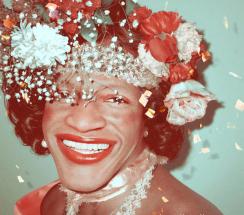 Although she regularly said her middle initial stood for “Pay it no mind”, Marsha P. Johnson proved to be a difficult person not to notice. Though Johnson is commonly referred to using female pronouns (she/her/hers) — and I’ll be doing that here — her actual gender identity is a bit of a mystery. She variously described herself as gay, a transvestite, and as a (drag) queen — though words like “transgender” really weren’t being widely used yet during her lifetime. My personal opinion is that she would probably identify as gender non-conforming or non-binary, but make your own judgments.
Although she regularly said her middle initial stood for “Pay it no mind”, Marsha P. Johnson proved to be a difficult person not to notice. Though Johnson is commonly referred to using female pronouns (she/her/hers) — and I’ll be doing that here — her actual gender identity is a bit of a mystery. She variously described herself as gay, a transvestite, and as a (drag) queen — though words like “transgender” really weren’t being widely used yet during her lifetime. My personal opinion is that she would probably identify as gender non-conforming or non-binary, but make your own judgments.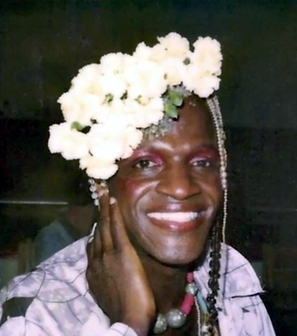 She also began to perform as a drag queen — initially going by the name “Black Marsha” before settling on Marsha P. Johnson. She was often recognizable for having flowers in her hair — something she began doing after sleeping under flower sorting tables in Manhattan’s Flower District. She usually had on bright colored wigs, shiny dresses, and long flowing robes. Marsha was known to be peaceful and fun, but there was a violent and short-tempered side to her personality (which her friends commonly called “Malcolm”) — leading some to suspect that she suffered from schizophrenia. Between her sex work and her occasional violent outbursts, Johnson claimed to have been arrested more than a hundred times.
She also began to perform as a drag queen — initially going by the name “Black Marsha” before settling on Marsha P. Johnson. She was often recognizable for having flowers in her hair — something she began doing after sleeping under flower sorting tables in Manhattan’s Flower District. She usually had on bright colored wigs, shiny dresses, and long flowing robes. Marsha was known to be peaceful and fun, but there was a violent and short-tempered side to her personality (which her friends commonly called “Malcolm”) — leading some to suspect that she suffered from schizophrenia. Between her sex work and her occasional violent outbursts, Johnson claimed to have been arrested more than a hundred times.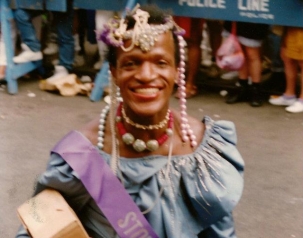 In 1973, Johnson also performed with the Angels of Light drag troupe — taking on the role of “The Gypsy Queen” in their production of “The Enchanted Miracle”. That same year both Johnson and Rivera were banned from participating in New York’s gay pride parade — the committee organizing the parade felt that drag queens and transvestites brought negative attention and gave the cause “a bad name.” In response, Rivera and Johnson marched ahead of the beginning of the parade.
In 1973, Johnson also performed with the Angels of Light drag troupe — taking on the role of “The Gypsy Queen” in their production of “The Enchanted Miracle”. That same year both Johnson and Rivera were banned from participating in New York’s gay pride parade — the committee organizing the parade felt that drag queens and transvestites brought negative attention and gave the cause “a bad name.” In response, Rivera and Johnson marched ahead of the beginning of the parade.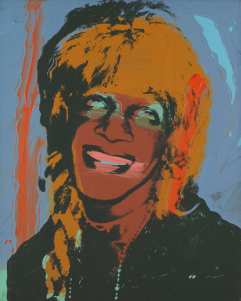 In 1975, Andy Warhol took pictures of Johnson for his “Ladies and Gentlemen” series. Johnson’s success as an activist and a performer, as well as her regular appearances throughout the decade, earned her the nickname “Mayor of Christopher Street.”
In 1975, Andy Warhol took pictures of Johnson for his “Ladies and Gentlemen” series. Johnson’s success as an activist and a performer, as well as her regular appearances throughout the decade, earned her the nickname “Mayor of Christopher Street.” June 23 is a pretty big day for LGBT+ people, apparently. Not only is it my birthday (and isn’t that enough?) and the birthday of
June 23 is a pretty big day for LGBT+ people, apparently. Not only is it my birthday (and isn’t that enough?) and the birthday of